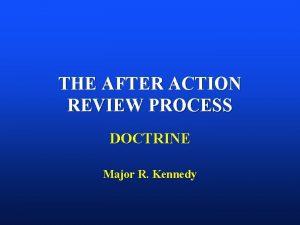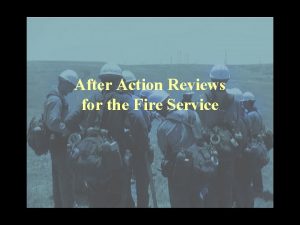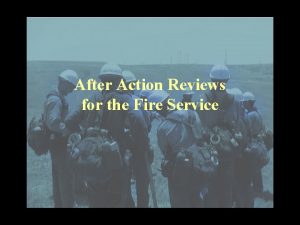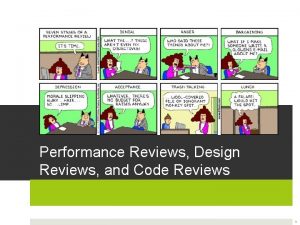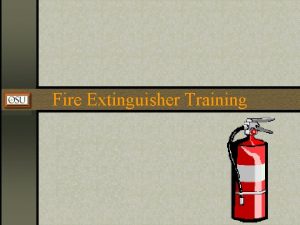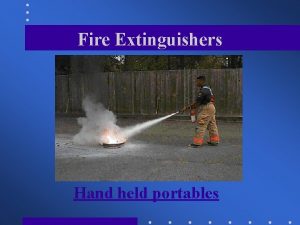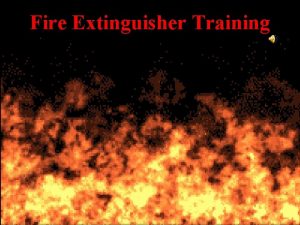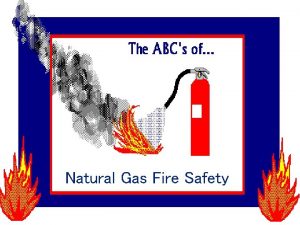After Action Reviews for the Fire Service After































- Slides: 31

After Action Reviews for the Fire Service

After Action Reviews Course Intent: To develop a better understanding of the concept, tools, and techniques of facilitating an effective AAR. To challenge everyone in this room to make the AAR a part of your culture.

After Action Reviews Unit 1 Objective: Understanding the AAR Understand the purpose, history, and theory of the AAR process

After Action Reviews Purpose Why use the AAR? The AAR is a learning tool intended for the evaluation of an incident or project in order to improve performance by sustaining strengths and correcting weaknesses.

After Action Reviews Purpose How is an AAR used? AARs may be conducted at any organizational level. However, all AARs follow the same general format, involve the exchange of ideas and observations, and focus on improving proficiency.

After Action Reviews Purpose What an AAR is NOT! • Investigation tool • Disciplinary tool • Critical Incident Stress Debriefing

After Action Reviews History Where did it come from? A post-Vietnam War resurgence of organizational learning within the U. S. Army led to the modern AAR format It was institutionalized by the U. S. Army Combat Training Centers as a way to capture lessons from simulated battles and rapidly implement improvements.

After Action Reviews History How long did it take? It was a decade before the process was fully accepted and embedded in the culture. This organizational learning method was proven by the U. S. Army’s performance in the Gulf War.

After Action Reviews History More background on the AAR Discussion with Mark Smith, retired Senior Noncommissioned Officer, U. S. Army Special Operations and leadership development consultant with Mission-Centered Solutions. Click here to view AAR video from You. Tube

After Action Reviews Theory What does an AAR look like? It should encourage input from participants focused on: • What was planned • What actually happened • Why did it happen • What can be done the next time

After Action Reviews What was planned? • Establishes what was planned at the beginning of the operational period. • Measures whether or not personnel understood what was expected of them at the beginning of the operational period.

After Action Reviews What actually happened? • Pool multiple perspectives to build a shared picture of what happened. • Identify changes that happened during the assignment that differed from the original briefing. • Measures the effectiveness of briefings and whether changes in assignments were communicated to everyone.

After Action Reviews Why did it happen? • Draw out explanations of what occurred. • Analysis of cause and effect…focus on WHAT not WHO.

After Action Reviews What can we do next time? Improve on Weaknesses Identify actions or procedures that can be executed more efficiently. Sustain/Maintain Strengths Identify areas where groups are performing well and should sustain.

After Action Reviews Unit 2 Objectives: Facilitation 1. Understand the key considerations for effective AAR facilitation. 2. Recognize barriers that may occur while facilitating an AAR and techniques that can be utilized to address those barriers.

After Action Reviews Facilitation Considerations Timing Ground Rules

After Action Reviews Timing As a leader, time your AARs so that they can be as effective as possible.

After Action Reviews Timing Emotion and memory are chemically linked in the brain. Your brain remembers things when there is an emotional attachment to the experience. As time goes by, the emotional attachment fades along with specific memory.

After Action Reviews Timing AARs occurring soon after the action tend to be more detailed, techniquespecific, emotional and therefore more effective.

After Action Reviews Timing Crews and teams that integrate AARs into their daily routine are more successful in keeping the practice alive as stress and time demands increase during a busy fire season.

After Action Reviews Ground Rules 1. Make sure that everyone participates 2. Allow all crewmembers the opportunity to share honest opinions and learn from each other. 3. The AAR focuses on WHAT happened, not WHO did it.

After Action Reviews Ground Rules 4. Reinforce that it is OK to disagree. Differing points of view and conflicts need to be addressed. (Disagreement is not disrespect) 5. Tact and civility are required… personal attacks are forbidden.

After Action Reviews Ground Rules 6. Go through the event in a logical sequence and compare performance against the task and intent. According to U. S. Army guidelines, roughly 25% of the time should be devoted to the first two questions, 25% to the third question, and 50% to the fourth question.

After Action Reviews Ground Rules 7. The facilitator enters the discussion only when necessary to keep things focused. 8. End on a positive note.

After Action Reviews Optional Video Part 1 Watch an example of a basic AAR being conducted and then discuss your observations.

After Action Reviews Environmental Barriers • • • Fatigue Stress Hunger Time Slow shift…nothing to talk about

After Action Reviews Human Factor Barriers • • • Dominant personalities Quiet personalities Conflicting personalities Disbelief in the process Denial…unwilling to accept accountability

After Action Reviews Optional Video Part 2 Watch examples of a facilitator dealing with barriers that may be encountered during an AAR and then discuss your observations.

After Action Reviews Ending on a Positive Note Make it a part of your culture Unless After Action Reviews are carried out routinely at all levels of the organization, they will never be viewed as more than an interesting diversion. Consistency breeds acceptance.

After Action Reviews The following persons were responsible for the development of this training package

Subject Matter Experts Tom Bates Jim Cook Heath Cota Anthony Escobar Nate Lancaster Leif Mathiesen Ron Napoles Mark Smith Keren Ramsey Eric Walker Sawtooth IHC, USFS / R-4 USFS / NIFC Sawtooth IHC, USFS / R-4 AFMO, Bakersfield BLM Bonneville IHC, BLM Kern Valley IHC, BLM Mission Centered Solutions Redding IHC, USFS/R-5 Boise Smokejumpers, BLM Video Production Bob Kambitsch A. V. Specialist, BLM/BIFC
 The two doctrinal types of after action reviews are:
The two doctrinal types of after action reviews are: After me after me after me
After me after me after me John 14:1
John 14:1 Reichstag fire who was the fire starter
Reichstag fire who was the fire starter Damper interface panel
Damper interface panel Fire hose reel signage standards
Fire hose reel signage standards Ire fire fire rwi
Ire fire fire rwi Race fire safety
Race fire safety A bicycle changes color as it rusts physical or chemical
A bicycle changes color as it rusts physical or chemical Charcoal in a fire turns to ash after several hours.
Charcoal in a fire turns to ash after several hours. Formuö
Formuö Typiska novell drag
Typiska novell drag Nationell inriktning för artificiell intelligens
Nationell inriktning för artificiell intelligens Returpilarna
Returpilarna Shingelfrisyren
Shingelfrisyren En lathund för arbete med kontinuitetshantering
En lathund för arbete med kontinuitetshantering Personalliggare bygg undantag
Personalliggare bygg undantag Personlig tidbok
Personlig tidbok Sura för anatom
Sura för anatom Vad är densitet
Vad är densitet Datorkunskap för nybörjare
Datorkunskap för nybörjare Boverket ka
Boverket ka Tes debattartikel
Tes debattartikel Autokratiskt ledarskap
Autokratiskt ledarskap Nyckelkompetenser för livslångt lärande
Nyckelkompetenser för livslångt lärande Påbyggnader för flakfordon
Påbyggnader för flakfordon Vätsketryck formel
Vätsketryck formel Offentlig förvaltning
Offentlig förvaltning Jag har nigit för nymånens skära text
Jag har nigit för nymånens skära text Presentera för publik crossboss
Presentera för publik crossboss Jiddisch
Jiddisch Vem räknas som jude
Vem räknas som jude
